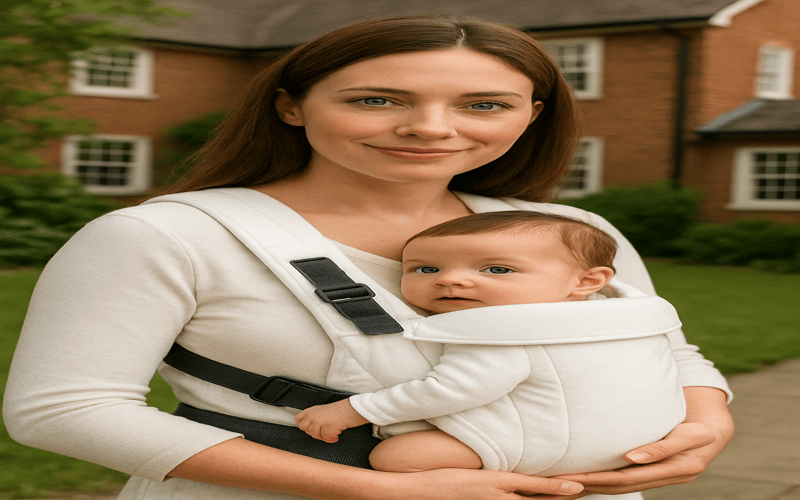
1.Introduction
Many parents wonder, is baby carrier safe for newborn? Baby carriers are becoming more popular because they keep little ones close while allowing parents to stay hands-free. For new mothers and fathers, this can be a lifesaver, especially during busy daily routines. However, safety is always the first concern. The right carrier can support a newborn’s head, neck, and hips while providing comfort and bonding. This guide explains everything parents need to know—from age suitability and hip health to breastfeeding and safety tips—so you can carry your baby with confidence and peace of mind.
2.Baby Carriers for Newborns
Carriers help parents keep their little one close and hands-free. For newborns, the carrier must give full head, neck, and back support. Wraps, slings, and soft-structured styles are common, but parents should choose one that keeps the baby upright, secure, and comfortable.
Types of Carriers (Wraps, Slings, Soft-Structured)
- Wraps: A long fabric you tie around your body. It gives a snug fit and is great for skin-to-skin bonding.
- Slings: A wide cloth worn over one shoulder. Easy to put on and quick for short use.
- Soft-Structured Carriers: Come with padded straps and buckles. They give more comfort and support, especially for longer wear.
Importance of Head, Neck, and Back Support
Newborns have soft muscles and cannot hold their head by themselves. Any carrier must give strong support to the head, neck, and spine. The baby should sit in a natural position with the back slightly curved and the face always visible. Proper support keeps breathing clear, prevents strain, and helps healthy growth.
3.Is Baby Carrier Safe for 3 Month Old?
At three months, most babies have better neck and head control compared to a newborn. This makes using a carrier easier and more comfortable. Still, full support is important. The baby should be kept upright, close to the parent’s chest, with the back and hips in a natural position. Parents should avoid forward-facing too early and always check the baby’s breathing and comfort.
Difference Between Newborn and 3-Month-Old
A newborn has very weak muscles and needs full head and neck support. By three months, most babies develop more strength, start holding their head better, and have improved body control. This makes carrying a bit easier, but the choice of carrier and correct position still matter.
Better Neck Control but Still Need Support
Even with stronger neck muscles, a three-month-old is not fully independent. The carrier should keep the baby upright, close, and well-supported. The head, spine, and hips must stay in a natural position. Extra care is needed to prevent slumping, and parents should avoid forward-facing positions until the baby grows older.
Discover the best soft structured baby carrier for comfort, safety, and support, helping parents enjoy hands-free newborn bonding daily.
4.Are Baby Carriers Safe for Babies’ Hips?
Baby carriers are safe for hips when used in the right way. If the legs hang straight down, it may put pressure on the joints and lead to hip dysplasia. The safe way is the M-position, where the knees are higher than the bottom and legs are spread like a frog. This posture keeps the hips in a healthy, natural shape and supports proper growth.
Risk of Hip Dysplasia if Used Incorrectly
If a baby is positioned with the legs hanging straight down, the hip joints may not grow in a healthy, natural way. This posture puts pressure on delicate joints and increases the risk of hip dysplasia, a condition where the hips are unstable. Poorly designed carriers or incorrect positioning can worsen the problem, making it important for parents to choose ergonomic carriers that encourage the safe “M-position.”
Importance of M-Position (Frog-Leg)
For hip safety, the baby’s legs should be spread apart with knees higher than the bottom, forming a natural “M-shape.” This position supports healthy hip growth and keeps the joints safe. Many ergonomic carriers are made to hold babies in this posture, which is also recommended by health experts.
5.Is Baby Carrier Safe for Newborn Breastfeeding?
Breastfeeding in a carrier can be very helpful for parents. It allows hands-free nursing, closer bonding, and more privacy in public. However, safety must come first. The baby’s face should always be visible, with nose and mouth uncovered. Keep the chin off the chest and prefer an upright position. After feeding, return the infant to a supported posture.
Benefits of Breastfeeding in Carrier
Feeding a baby while using a carrier can be very convenient for parents. It makes nursing hands-free, keeps the little one close, and strengthens emotional bonding. At the same time, it provides a sense of privacy, allowing mothers to breastfeed confidently and comfortably even when outside the home. With the right positioning and attention to safety, babywearing during feeding becomes a practical and nurturing choice.
Safety Tips Airway Clear, Upright Position
While nursing, the baby’s airway must stay open at all times. Keep the chin off the chest, and never let fabric cover the nose or mouth. An upright position is safer, as it reduces the risk of blocked breathing. After feeding, always adjust the infant back into a secure and supported position.
6.Essential Safety Tips
Safe babywearing depends on a few simple rules. Always follow the T.I.C.K.S. guide to keep the infant secure. Use light fabric to prevent overheating, and give breaks instead of keeping the little one inside for long hours. Most importantly, pick a carrier that matches your baby’s age, so the head, neck, and hips get proper support.
Follow T.I.C.K.S. Rule
Always remember the T.I.C.K.S. safety rule when using a baby carrier. Keep the carrier Tight, the baby In view, Close enough to kiss, chin off the chest, and the back supported. Following these simple yet essential steps ensures your little one stays safe, comfortable, and secure while you enjoy hands-free bonding. A safe carrier means peace of mind.
Avoid Overheating and Long Use
Choose breathable fabric, especially in hot weather. Do not keep the baby in the carrier for long hours without breaks, as it may cause discomfort or overheating.
Choose Age-Appropriate Carriers
Select a carrier designed for your child’s age and stage of development. Infant-friendly designs provide proper head, neck, and hip support, reducing safety risks.
7.When to Avoid Baby Carriers
Babywearing is helpful, but not always safe. If a child is premature or has medical issues, carriers should only be used with a doctor’s advice. Also, avoid any design that does not give proper head, neck, and hip support. Using the wrong type can cause discomfort and health risks, so always choose carefully.
Premature Babies or Medical Concerns
If an infant is born prematurely or faces breathing difficulties, heart conditions, or other health concerns, parents should avoid using carriers unless specifically advised by a medical professional. These little ones often need additional monitoring, specialized positioning, and extra support that most standard carriers cannot provide. Consulting a doctor ensures the baby’s safety, prevents potential risks, and helps parents make the best decision for their child’s well-being.
Carriers Without Proper Support
Not every baby carrier is designed with infant safety in mind. If the model does not support the head, neck, or hips in a natural position, it increases the risk of discomfort or even injury. Parents should carefully select only carriers specifically created for newborns, ensuring proper ergonomic design and trusted safety features that protect delicate development while offering comfort and closeness.
Conclusion
So, is baby carrier safe for newborn? The answer is yes—when parents use the right design, follow safety rules, and pay close attention to positioning. Newborns need full support for the head, neck, and hips, and carriers that keep them upright and close are the safest choice. Whether for bonding, breastfeeding, or comfort, a well-fitted carrier can make daily life easier. Always check for ergonomic features, avoid overheating, and follow expert advice. With care and the correct carrier, parents can enjoy the benefits of babywearing while keeping their little one safe and secure.
FAQS
1.Is it safe to carry a newborn in a baby carrier?
Yes, carrying a newborn is safe if the carrier supports neck, hips, and allows clear breathing with proper upright positioning.
2.What are the side effects of baby carriers?
Incorrect use may cause hip strain, breathing issues, or overheating. Choosing ergonomic carriers and following safety rules reduces such risks effectively.
3.Can I put my 2 week old in a baby carrier?
Yes, if using a soft newborn carrier that keeps baby upright, visible, supported, and ensures airway safety during short, monitored periods.
4.What is the best age to use a baby carrier?
Carriers work from birth with newborn inserts, but many parents feel more confident after three months when babies gain stronger head control.
